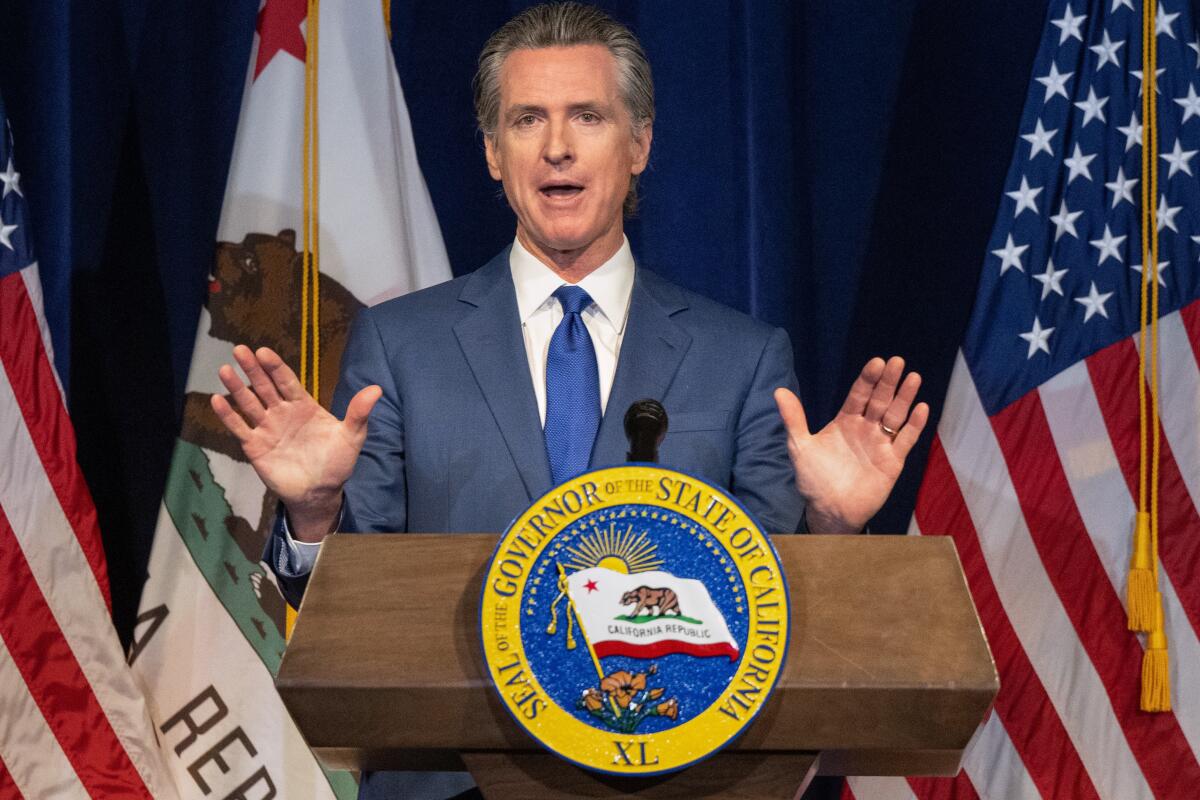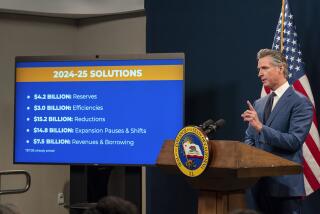Column: Newsom’s budget math doesn’t add up

SACRAMENTO — Gov. Gavin Newsom has sent the Legislature a proposed state budget that is unrealistic and spews red ink.
That’s essentially the straight-shooting opinion of the most trusted numbers-crunching outfit in Sacramento: the nonpartisan Legislative Analyst’s Office.
By law, the annual budget must be balanced. But “balanced” is a subjective characterization based on guesswork. Often it’s rooted in wishful thinking and fudged calculations.
The revised $307-billion budget proposal that Newsom recently submitted — known colloquially as the May Revision — is either too fat with spending or too thin on taxes, Legislative Analyst Gabriel Petek asserted.
Newsom and the Legislature need to fix one — or both — before the June 15 deadline for passing a budget. That means cutting programs or raising taxes — or a little of both.
“There is less than a one-in-six chance the state can afford the May Revision spending level across the five-year period,” the LAO cautioned. “This means that if the Legislature adopts the governor’s May Revision proposals, the state very likely will face more budget problems over the next few years.”
That would mean even deeper program cuts or steeper tax hikes in a state where tax rates already are among the highest — if not the highest — in the nation. That’s not exactly a good sales pitch for outside investment.
Newsom, however, denies this is a high-tax state for 99% of Californians and insists “I’m not a tax-and-spend liberal.”
In fact, he has flatly rejected — so far — an effort by Senate Democratic leaders to raise corporation taxes on net incomes exceeding $1.5 million.
“I do not think it’s the right time to raise taxes,” he said.
And for that he drew uncommon praise last week from an unlikely source: Jon Coupal, president of the Howard Jarvis Taxpayers Assn.
“Give some credit where credit is due,” Coupal wrote in a column. “Despite heavy pressure from far-left progressives in the Legislature and public sector labor organizations, the governor is not proposing any significant tax increases.”
That presumably pleases most voters. But since he has rejected the lefties’ urge to tax and spend, he’d better practice some righty program cutting.
Newsom finds himself in an unaccustomed role. Budget trouble is a new predicament for him. Until now, he has been lucky enough to escape the politically risky dilemma that has confronted virtually every California governor for the past 64 years: the need to erase budget deficits, usually with higher taxes plus spending cuts.
Exactly one year ago, Newsom and the Legislature were basking in a $100-billion budget surplus.
Now, Newsom is projecting a deficit for the fiscal year starting July 1 of nearly $32 billion. The LAO pegs it a bit higher at close to $35 billion. Over the next four years, the analyst projects cumulative deficits of $52 billion.
How did the budget turn from black to red?
Inflation, rising interest rates, bank closures — all of that suppressed the economy, particularly the stock market, and resulted in reduced state tax revenues.
One culprit is California’s ultra-progressive state income tax that Newsom lauds. “Soak the rich” may be a popular concept, but it results in a very volatile tax system that leans too heavily on the wealthy. The top 1% of California earners pay nearly 50% of the state income tax. And when the economy staggers and falls, so do wealthy people’s capital gains and they pay less taxes.
A unique problem this year is abnormal uncertainty.
One uncertainty has been whether President Biden and Congress could raise the debt limit in time to avert a federal default and economic chaos. That probably was resolved by a weekend agreement between Biden and House Speaker Kevin McCarthy (R-Bakersfield).
Another uncertainty comes from the federal and state governments extending the tax-filing deadline from April to October for Californians because of winter storms. No one at the state Capitol can be sure of how much income and corporate taxes will be flowing in, but the administration is guessing around $42 billion.
“We’ve never had a delay of that many months,” says H.D. Palmer, spokesman for the state finance department. “It’s a new level of uncertainty we haven’t had to deal with before.”
It’s all the more reason to prepare for the worst and begin prudent cutting of programs, including some pets — such as Newsom’s favorite climate and healthcare projects. One is Medi-Cal coverage for all eligible low-income people regardless of their immigration status.
Newsom thought he was being fiscally wise by relegating some spending to “one-time only.” But the LAO now says the state doesn’t even have enough money for that.
“Most of this spending no longer appears to be affordable,” the analyst says.
Last year, the governor and Legislature agreed to temporary one-year spending that totals $28 billion. Newsom recently cut that back to $11 billion. The LAO recommends whittling it further to $4 billion.
It also lists other options without specifically recommending one. These potential fixes include “cost shifts” — grabbing money from one program and spending it on another, or dumping more burden on local governments.
They could dip into rainy-day reserves. But Newsom rejects that idea for now, theorizing the saved stash may be needed later. And the LAO agrees. But the Legislature may attempt to seize the easy money anyway. It always wants to spend more than the governor does.
This year there isn’t enough tax revenue for any Democratic spending plan that has emerged.
“It’s pretty unlikely the state can afford the May Revise proposal,” says analyst Ann Hollingshead, who prepared the LAO report. “There’s too much spending or not enough revenue.”
The governor and Legislature can always ignore the LAO warnings and craft a fantasy budget that compounds the state’s problems down the road. That would be standard for Sacramento.
More to Read
Sign up for Essential California
The most important California stories and recommendations in your inbox every morning.
You may occasionally receive promotional content from the Los Angeles Times.











